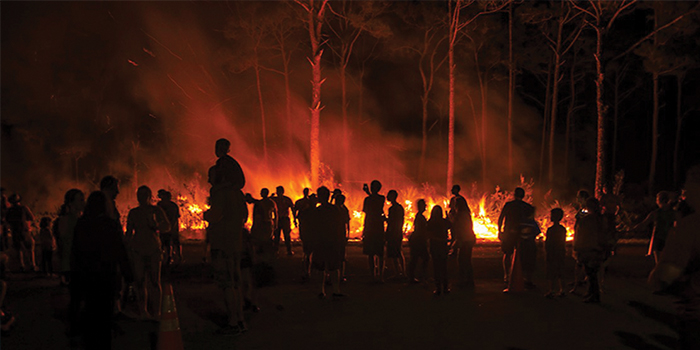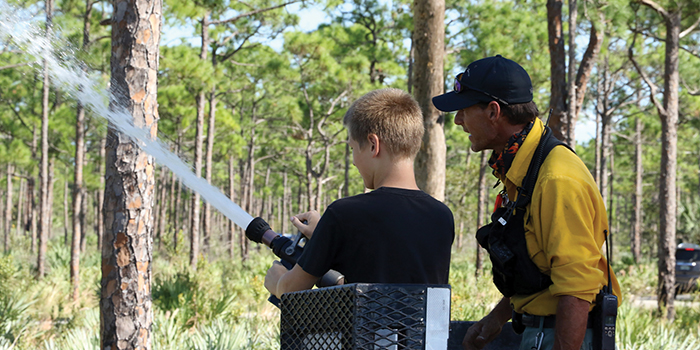DreamMaker Bath and Kitchen
- (561) 459-1004
- email us
- Jupiter, Florida, United States

JUPITER, FL – August , 2017 – If you live in Hobe Sound, you know about fire in natural areas because Hobe Sound is blessed with having so much undeveloped land around it. We know that humans can set fires, but to understand fire as a natural phenomenon we must look at the weather. During May and June, regular afternoon thunderstorms start to inundate us with rain. Along with the rain comes lightning, and Florida is the lightning capital of the United States. Lightning is also the spark that sets off some many wildfires during this time period in Florida. This phenomenon has been happening for so long that many different plants and animals require fire in their ecosystem in order to survive. In fact, if you look at any list of rare species in Florida, those in Jonathan Dickinson State Park (JDSP) included, you will find that many actually need fire to survive.
The mission of the Florida Park Service (FPS) is to provide resource-based recreation while preserving, interpreting, and restoring natural and cultural resources. More specifically, the goal of the FPS is to manage natural resources as an example of what Florida was like prior to European discovery. With that in mind a second set of principles is also important. To that end, Smokey Bear was created in the 1940s to spread the message: “Only you can prevent forest fire.” This philosophy has been successfully indoctrinated into our culture. However, in Florida, this message is at odds with how nature operates.
In the early 1970s, park rangers, biologists, and managers recognized that fire is a natural part of Florida’s landscape. However, wildfire is an unacceptable way of managing our properties, as the risks to humans and their property are too high, so the FPS began its prescribed burn program. In 1971, the park’s staff conducted the first documented prescribed burn at JDSP (As an aside, in April 1971 there was a large wildfire within JDSP that spread across US1 and to Jupiter Island).

Fire Saves Woodpeckers and Scrub-jays
In 1983, despite efforts by staff, JDSP lost its last Red-Cockaded Woodpecker (RCW)*. RCWs are small, inconspicuous woodpeckers that specialize in living in old, live Slash Pines in areas with an open understory – a habitat maintained by frequent fire intervals of somewhere between two to four years.
In addition to the Federally Endangered RCWs, which are inhabitants of the Pine Flatwoods ecosystem, Scrub-jays are another bird species that need fire to maintain their populations. Estimates in the 1990s placed the number of Scrub-jays within JDSP at around 300 individuals. Currently there are many fewer numbers of this animal in the park today – maybe around 40. Scrub-jays live in the higher drier parts of the park, usually in the Scrub or Scrubby Flatwoods ecosystems, and need regularly burned areas to successfully reproduce. Scrub ecosystems have much coarser fuels than Pine Flatwoods and; therefore, burn naturally at longer intervals (every 10 to 40 years) and are more difficult to control. However, through prescribed fire (and some wildfire) we are continuing to put fire into JDSP’s Scrub and hope that the small scale spread of Scrub-jays we have seen in the past couple of years will continue as a result.
Some might ask, “Why does JDSP manage for these species?” The truth is, our philosophy is to manage the land according to each specific ecosystem’s scientifically accepted fire interval. This means that we let the individual species of plants or animals thrive with a minimum of oversight. Many species benefit from prescribed fire, and our goal is to demonstrate this fact to our visitors both through land management and education. A secondary, but major side benefit to our community is that if we continue to use prescribed fire as a management tool the neighboring homes, roads, and people will be much safer. Prescribed fire is one of the most difficult, and sometimes controversial subjects that we deal with, and we need continued support from the community to help us achieve our goals.
*One of the long-term goals of the prescribed fire program at JDSP is to get to a point where the re-introduction of RCWs is possible, as was done recently in the nearby Hungryland Slough Wildlife and Environmental Area off of Pratt-Whitney Road (managed by Florida Fish and Wildlife Conservation Commission).

| The Lasting Benefits of Prescribed Burning By Natasha Warraich Frequent visitors to Jonathan Dickinson State Park are aware that we conduct prescribed burns regularly throughout the year, but not everyone is familiar with the process of preparing and executing a burn. In order to understand the process we first have to understand the reasons for burning. Fire is used as a tool by the Florida Park Service for ecological improvement and public safety. Most residents of South Florida are aware of frequent summer thunderstorms, bringing intense lightning that can start wildfires. Before the arrival of Europeans, wildfires were a natural and necessary part of Florida’s ecosystems that burned the pine forests every two to five years. Native plants and wildlife flourish under these conditions by going to seed after a fire or opening up habitat where they can more successfully raise young. We now try to mimic these conditions, as closely as we safely can, with prescribed fire. When more frequent fires are allowed to burn through fire-dependent communities, flame lengths are short and fire intensity is moderated. Low-intensity fires rarely damage Slash Pines. Conversely, if ground fuels are allowed to build up for years without being eliminated by frequent, low-intensity fires, the inevitable lightning-sparked wildfire runs the risk of turning into a huge inferno, fed by the heavy fuel load that has accumulated. The risk of these catastrophic events can be all but eliminated through regular, careful prescribed burning. Many variables must be considered to plan a burn. The ecological needs of the property, weather, equipment, personnel, fire line preparation, and fuel levels in surrounding zones all need to be evaluated before starting a fire under prescribed conditions. There are over 70 different management zones in Jonathan Dickinson State Park, each with its own burn return interval and burn plan. So, while it may seem like we are burning an area often, what is likely happening is that we are burning adjacent zones at different intervals. When we burn at Jonathan Dickinson State Park we use large off-road fire engines supplemented with one to two engines from nearby parks. On-site burn crews range from eight to 20 experienced people, often including staff from other state and local agencies. So much depends on weather conditions that the actual decision to burn is not started until a day or two in advance. When the decision is made to attempt the burn on a particular day, neighbors and area agencies are notified. Then, on the morning of the attempt, a permit is sought from the Florida Forest Service; without their consent, no burning can go forward. Once the permit is secured and all other factors on all checklists have been satisfied, we begin. The burn itself generally takes a full working day (six to 10 hours). Patrol and mopping-up, which means securing the perimeters of the zone and ensuring that the fire is completely contained, lasts for several days to a few weeks depending on the conditions. Within only a couple of days (really!), grasses begin to re-sprout from the ash and wildlife is seen nibbling on the fresh, nutrient-rich vegetation. Burn prescriptions generally call for burning when the wind is such that the smoke from the fire will be blown into the park and/or away from major highways, schools, or hospitals. Strict smoke management laws forbid us from allowing smoke from our fires to settle on roads or highways, schools, hospitals, etc. And of course, we try never to let our smoke blanket our neighbors. It is likely that you will see smoke from the burn zone for a few days after the date of the fire. This is normal after a burn and is not a cause for alarm. We welcome questions regarding prescribed burning and encourage everyone to attend Fire Fest, the park’s annual event with opportunities to meet fire-fighters, learn more about this important tool, and see a prescribed burn in progress. |
For more information on prescribed burns at Jonathan Dickinson State Park and Fire Fest, please visit https://www.floridastateparks.org/park/Jonathan-Dickinson

Jupiter, Florida, United States | (772) 546-2771, email us